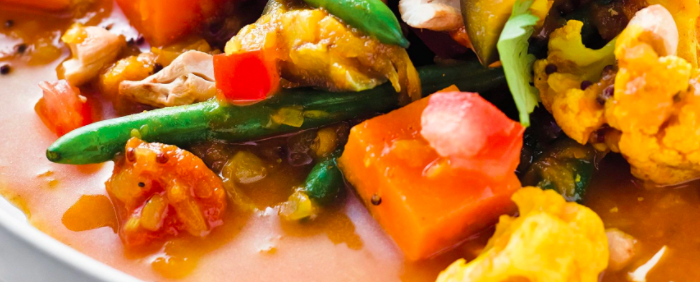
Curry is not a spice as we often think but a mixture of spices. We find curry in Indian dishes. The benefits of curry are linked to the spices that make it up, so check the spices in your curry to deduce the benefits
Characteristics of curry:
- Rich in antioxidants;
- Fight against the signs of aging;
- Facilitates digestion;
- Source of vitamin E;
- Strengthens the immune system.
What is curry?
Curry identity card
- Type: Spice;
- Origin: India;
- Yellow color ;
- Flavor: Sweet or spicy.
Curry characteristics
Madras curry, originally from India, is the most common. It includes:
- Red pepper
- Turmeric
- Coriander seeds
- Cumin
- Mustard seeds
- Black pepper
- Caloupilé leaves
- Ginger
- Dried garlic
In other curries, we can also find the following spices:
- Cubèbe
- Broken
- Fenugreek
- Cardamom
- Cloves
- Fennel
- Onion
- Salt
Word from the nutritionist
Curry is a mixture of spices used at a rate of a few grams in recipes. These benefits should therefore be put into perspective given the small dose of curry ingested during your meals. Remember to bring enough fruits and vegetables into your diet to cover your needs for vitamins, minerals and trace elements.
Nutritional values
For 100g of curry:
| Water | 8.8g |
| Carbohydrates | 2.63 g |
| Fat | 14 g |
| Protein | 14.5g |
| Calcium | 525 mg |
| Iron | 19 mg |
| Iodine | 0.5 µg |
| Magnesium | 255 mg |
| Manganese | 8.3 mg |
| Potassium | 1170 mg |
| Vitamin E | 25.2 mg |
| Vitamin K1 | 99.8 µg |
| Energy | 301 kcal |
| Energy | 1230 kJ |
8 benefits of curry: why eat it?
- It is the ginger, coriander and turmeric contained in the curry that allow to have a beneficial effect against cellular aging thanks to their antioxidant content.
- Black pepper, often present in the composition of curry, stimulates the secretion of gastric juices and helps the digestive process.
- The cardamom that is found in most curries will help reduce stomach spasms and thus limit nausea and vomiting.
- The magnesium present in significant quantity in the curry will help to help the functioning of muscles, nerves but also the intestines.
- Your natural defenses will be strengthened thanks to the manganese present in ginger and cardamom.
- If your curry contains cumin and pepper, you can be confident that it has a good potassium content. Potassium will in particular allow the transmission of nerve impulses in your body and will help the contraction of muscles and the heart.
- The antioxidant action of curry is hidden in vitamin E, it will in particular help to prevent cardiovascular diseases thanks to its anti-aggregating role.
- This vitamin provided by coriander will also prevent cardiovascular diseases, it has antihemorrhagic properties.
Choosing the right curry
You will recognize a good quality curry if you can distinguish different color pigments corresponding to the spices contained in it. An Indian curry should not contain salt, the many spices give enough taste if they are mixed in the right proportions.
The classic curry has a color ranging from yellow to orange, there is also a red curry (based on red peppers) and a green curry (based on herbs).
Keep well
Be sure to leave the curry in its clean, airtight container to prevent the flavors from fading. It keeps away from light, heat and humidity.
Curry preparation
How to cook it? How to match it?
Curry is a very easy spice to incorporate into your recipes. Originally from India, it will particularly highlight Indian recipes such as curry chicken, shrimp with curry sauce, dishes based on coconut milk but also fish dishes. It goes particularly well with green beans, carrots, leeks or even salsify.
To develop all the flavors of curry, incorporate it from the start of cooking, mixing it with the fat used in your dish.
History of curry
Native to India and used for millennia, curry is the most variable spice blend on the planet. Legend has it that in India, each family has the recipe for their own curry, which can contain several dozen different spices.
Nowadays, the western curry recipe has been very simplified, we find on average 10 ingredients in a common curry, while we still put around fifty different spices in India.
Remember to taste the different curries during your travels, you will find that its flavor varies enormously depending on whether it comes from India, Reunion Island, Mauritius or Thailand.